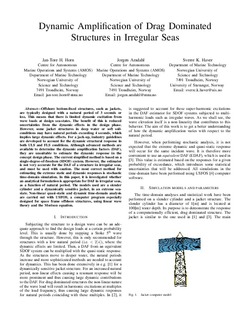| dc.contributor.author | Horn, Jan-Tore Haugan | |
| dc.contributor.author | Amdahl, Jørgen | |
| dc.contributor.author | Haver, Sverre Kristian | |
| dc.date.accessioned | 2016-01-11T10:15:12Z | |
| dc.date.accessioned | 2016-05-04T13:59:30Z | |
| dc.date.available | 2016-01-11T10:15:12Z | |
| dc.date.available | 2016-05-04T13:59:30Z | |
| dc.date.issued | 2015 | |
| dc.identifier.citation | IEEE, . [Eds.] Proceedings of OCEANS'15 MTS/IEEE Washington Conference & Exhibition p. 1-9, IEEE conference proceedings, 2015 | nb_NO |
| dc.identifier.isbn | 978-0-933957-43-5 | |
| dc.identifier.uri | http://hdl.handle.net/11250/2388655 | |
| dc.description.abstract | Offshore bottom-fixed structures, such as jackets,
are typically designed with a natural period of 3 seconds or
less. This means that there is limited dynamic excitation from
wave loads at design sea-states. The benefit of this is reduced
uncertainties from the dynamic effects in the design phase.
However, some jacket structures in deep water or soft soilconditions
may have natural periods exceeding 4 seconds, which
implies large dynamic effects. For a jack-up, industry guidelines
are developed to account for the dynamic structural response in
both ULS and FLS conditions. Although advanced methods are
available to determine the dynamic amplification factors (DAF),
they are unsuitable to estimate the dynamic response in the
concept design phase. The current simplified method is based on a
single-degree-of-freedom (SDOF) system. However, the estimator
is not very accurate for the DAF of a structure in irregular seas,
and must be used with caution. The most correct method for
estimating the extreme static and dynamic responses is stochastic
time-domain simulation. In this paper, it is investigated whether
an analytical formulation is appropriate for DAF in irregular seas,
as a function of natural period. The models used are a slender
cylinder and a dynamically sensitive jacket, in an extreme seastate.
Non-linear quasi-static and dynamic time-domain analysis
are carried out with USFOS, a computer program especially
designed for space frame offshore structures, using linear wave
theory and the Morison equation. | nb_NO |
| dc.language.iso | eng | nb_NO |
| dc.publisher | IEEE conference proceedings | nb_NO |
| dc.relation.ispartofseries | OCEANS'15 MTS/IEEE; | |
| dc.title | Dynamic Amplification of Drag Dominated Structures in Irregular Seas | nb_NO |
| dc.type | Chapter | nb_NO |
| dc.date.updated | 2016-01-11T10:15:12Z | |
| dc.description.version | acceptedVersion | |
| dc.identifier.cristin | 1309737 | |
| dc.relation.project | Norges forskningsråd: 223254 | nb_NO |
| dc.description.localcode | (c) 2015 IEEE. Personal use of this material is permitted. Permission from IEEE must be obtained for all other users, including reprinting/ republishing this material for advertising or promotional purposes, creating new collective works for resale or tion to servers or lists, or reuse of any copyrighted components of this work in other works. | nb_NO |
